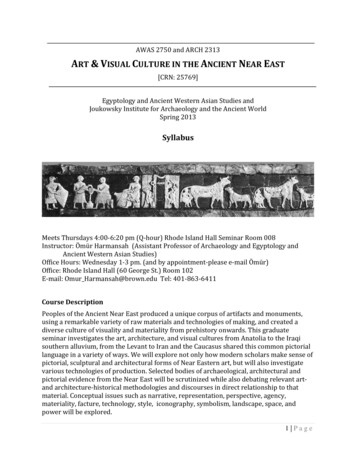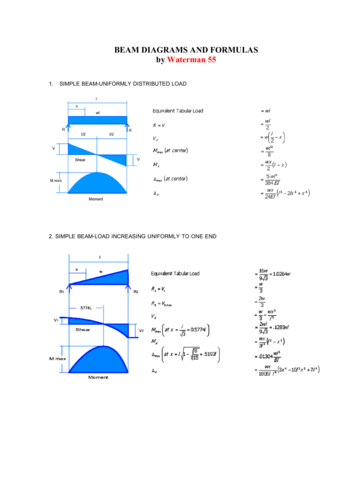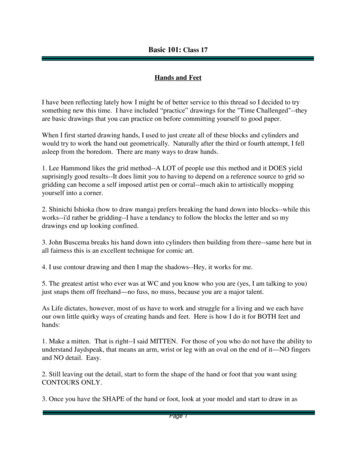
Transcription
AWAS 2750 and ARCH 2313ART & VISUAL CULTURE IN THE ANCIENT NEAR EAST[CRN: 25769]Egyptology and Ancient Western Asian Studies andJoukowsky Institute for Archaeology and the Ancient WorldSpring 2013SyllabusMeets Thursdays 4:00-6:20 pm (Q-hour) Rhode Island Hall Seminar Room 008Instructor: Ömür Harmansah (Assistant Professor of Archaeology and Egyptology andAncient Western Asian Studies)Office Hours: Wednesday 1-3 pm. (and by appointment-please e-mail Ömür)Office: Rhode Island Hall (60 George St.) Room 102E-mail: Omur Harmansah@brown.edu Tel: 401-863-6411Course DescriptionPeoples of the Ancient Near East produced a unique corpus of artifacts and monuments,using a remarkable variety of raw materials and technologies of making, and created adiverse culture of visuality and materiality from prehistory onwards. This graduateseminar investigates the art, architecture, and visual cultures from Anatolia to the Iraqisouthern alluvium, from the Levant to Iran and the Caucasus shared this common pictoriallanguage in a variety of ways. We will explore not only how modern scholars make sense ofpictorial, sculptural and architectural forms of Near Eastern art, but will also investigatevarious technologies of production. Selected bodies of archaeological, architectural andpictorial evidence from the Near East will be scrutinized while also debating relevant artand architecture-historical methodologies and discourses in direct relationship to thatmaterial. Conceptual issues such as narrative, representation, perspective, agency,materiality, facture, technology, style, iconography, symbolism, landscape, space, andpower will be explored.1 Page
The main objective of the seminar is not to provide students a comprehensive andthorough survey of art in Near Eastern history, therefore the readings do not concentrateon canonical textbook level works such as Henri Frankfort’s The Art and Architecture ofAncient Orient (1954), Anton Moortgat’s Art of Ancient Mesopotamia (1969), W. Orthmann’sPropyläen Kunstgeschichte. Band 14: Der alte Orient (1975), Pierre Amiet’s Art of the AncientNear East (1977), Dominique Collon’s Ancient Near Eastern Art (1995). All of these volumesare extraordinary efforts to make sense of Near Eastern art as a stream of tradition fromprehistory to the Hellenistic Period, yet most of them remain out of date and fail to coverthe central disciplinary debates in the field. The main objective here is first of all tounderstand where art historical approaches to ancient Near Eastern cultures stand, andobtain the best representative cross-section of the ongoing debates, its historiographicmethodologies, and its epistemological trends (those pertaining to knowledge production).This involves engaging with the central thinkers of the discipline today such as Irene J.Winter, Holly Pittman, Zainab Bahrani, John M. Russell, Ann Gunter, Marian Feldman andothers, understanding the evolution of the discipline in recent decades with impact frombroader disciplinary fields of Near Eastern Studies, art history, architectural history,archaeology, visual culture studies, material culture studies and cultural studies. What arethe intellectual foundations of the discipline and what cross-disciplinary currents of debateis it impacted by today?Books available at Brown BookstoreAtaç, Mehmet-Ali; 2010. Mythology of Kingship in Neo-Assyrian Art. Cambridge: CambridgeUniversity Press.Bahrani, Zainab; 2003. The Graven Image: Representation in Babylonia and Assyria.Philadelphia: The University of Pennsylvania Press.Benzel, Kim; Art of the Ancient Near East: A Resource for Educators. New York:Metropolitan Museum of Art. (Also exists online r-east)Feldman, Marian; 2006. Diplomacy by Design: Luxury Arts and an "International Style" in theAncient NearEast, 1400-1200 BCE. Chicago: Chicago University Press.Nelson, Robert S. and Richard Shiff; 2003. Critical terms for art history. Chicago: ChicagoUniversity Press.Gell, Alfred; 1998. Art and Agency: an Anthropological Theory. Clarendon Press.Course wikiA wiki is created for this course and we will use this site actively throughout the semester.Weekly reading materials, powerpoints, announcements, assignments and discussions willbe posted on the wiki. Students registered or auditing the course will have access tocontribute to the pages of the course wiki which facilitates collaborative work. At the end ofthe semester, the accumulated work within the frame of this seminar will be archived inthe wiki. Please familiarize yourself with the page, and make sure to check the siteregularly.2 Page
omeReadings and reservesAll readings will be posted on the course wiki in pdf format except for the readings frombooks that are available at Brown Bookstore (see the list above). Copies of those books willbe available at Rock Reserve Desk. I will also create a mini reserve library that will includea set of reference books. These will be kept on a specific shelf in the Joukowsky Institutelibrary (2nd floor corridor). Please use those books at the Institute and leave a note withyour e-mail address if you have to remove it from the building for any extended period oftime.Course RequirementsStudents are expected to do weekly readings comprehensively, and contribute to seminardiscussions as much as possible. A graduate seminar is only successful if all participantscollaborate effectively with critical debate and collegial responsibility.1. Presentations and leading discussionAll students will be asked to volunteer for short presentations in class on selected articlesor a specific body of archaeological/textual material, and to lead class discussion aroundthose materials. This will allow us to cover a larger body of literature collaboratively. Thepresentations should cover the gist of the argument in the article, raise relevant andprovocative discussion questions, and should last somewhere between 8-10 minutes atmost.2. Response PapersIn the first half of the semester (Weeks 2-6), the written tasks will involve a series of briefresponse papers (5 in total) in response to our discussions during the seminars (to beposted on the wiki one week after each discussion). These response papers will be brief,creative and dynamic essays that are inspired by some aspects of your weekly reading andthe discussion that ensues it.3. Research projectIn the second half, students will focus on their research project. There will be no exams.Students will choose a research topic in collaboration with Ömür and turn it into a project.The project should involve an analytical and critical discussion of a relevant art historicalproblem, or body of material or monument relevant to our seminar discussions (drawingcomparisons from outside the Near East are always welcome when relevant). It would bevery beneficial for the whole group if topics are elected from areas that are notcomprehensively covered during the regular gatherings, such as iconoclasm,connoisseurship, issues of heritage and museum exhibition, wall paintings, etc.The research project’s presentations will include3 Page
a project proposal of 250-300 words with preliminary bibliography (Due March15th)a 15-20 min class presentation (To be scheduled for April 18th and 25th)a 6-8 page paper draft, due on the day of your presentation. Feedback will follow.14-20 page final paper (12-font, double spaced, excluding images and bibliography)(Due May 13th)Grading will be based on class participation (20%), oral presentations (10%), responsepapers (20%), research project (50%). Class participation includes regular attendance andcontribution to seminar discussions. Since this is a seminar meeting only once per week,missing a class means missing a large quantity of material. Apart from sicknesses andfamily emergencies, please try not to miss any of the meetings. If you do have to miss the aseminar, arrange with Ömür for ways to make this up. Please note that an extra amount ofwriting assignment may be required from the students who miss seminar meetings.ResourcesIn this class, we will not be reading Some reference books that you can consult if you needbackground reading canonical text book type of material but we will be focusing on closereading of specific bodies of material or specific art historical problems to get a goodcrosssection of the disciplinary debates.Ömür’s research bibliography on JIAAW wiki is always helpful (although not updated inrecent years):http://proteus.brown.edu/harmansah/4971You have access to several study collections on ArtSTOR, a massive image database thatBrown Libraries are subscribed to:http://www.artstor.org/index.shtmlKaren A. Bouchard, the Scholarly Resources Librarian for Art and Architecture has kindlyoffered to help Art in Antiquity students, and she is accessible:Address: Rockefeller Library, Box A, 10 Prospect StreetPhone: (401) 863-3218 E-mail: Karen Bouchard@Brown.eduBrown Image Collection id 56435Reference Collection: (located in Joukowsky Institute Library Reserve Shelf, Rhode IslandHall 2nd Floor corridor)4 Page
Akkermans, Peter and Glenn M. Schwartz, The Archaeology of Syria: from Complex HunterGatherers to Early Urban Societies (c. 16,000-300 BC). Cambridge: CambridgeUniversity Press, 2003.Amiet, Pierre, Art of the Ancient Near East (translated from the French by John Shepley andClaude Choquet). New York: H. N. Abrams, 1980.Aruz, John; 2003. Art of the First Cities: The Third Millennium BC from the Mediterranean tothe Indus. Joan Aruz (ed.) New York: The Metropolitan Museum of Art, 84-88.Aruz, Joan, Kim Benzel, and Jean M. Evans; 2008. Beyond Babylon: Art, Trade andDiplomacy in the Second Millennium BC. New York: The Metropolitan Museum ofArt.Kuhrt, Amélie; 1995. The Ancient Near East: c. 3000-330 B.C. 2 Vols. Routledge: London andNew York.Moorey, Peter Roger Stuart; 1994. Ancient Mesopotamian materials and industries: Thearchaeological evidence. Clarendon Press: Oxford.Moortgat, Anton, The Art of Ancient Mesopotamia: The Classical Art of the Near East.London: Phaidon, 1969.Orthmann, Winfried, Der alte Orient (mit Beiträgen von Pierre Amiet et. al.). Berlin:Propyläen Verlag, 1975.Postgate, J. N., Early Mesopotamia : Society and Economy at the Dawn of History. London,New York: Routledge, 1992.Roaf, Michael; 1996. Cultural atlas of Mesopotamia and the Ancient Near East. Oxfordshire.Van de Mieroop, Marc; 2004. A history of the ancient Near East. ca 3000-323 BC. Oxford:Blackwell Publishing.5 Page
WEEKLY SCHEDULEWeek 1. January 24. Introduction. Discussion of goals, objectives, and format of theseminar.Week 2. January 31. What is art, art history, visual culture, visuality. The canon ofMesopotamian art history, and its critiques.Summers, David; 2003. “Introduction” Real Spaces: World Art History and Rise of WesternModernism. London: Phaidon, 15-60.Herbet, James D.; 2003. “Visual culture/visual studies” in Critical terms for art history. R.Nelson and R. Shiff (eds.) Chicago: Chicago University Press, 452-464.Owens, Craig; 1994. "Representation, appropriation and power," in Beyond recognition:representation, power, and culture. S. Bryson et. al. (eds.) Berkeley: University ofCalifornia Press, 88-113.Groenewegen-Frankfort, H.A.; 1987. “Mesopotamian art” in Arrest and Movement: Spaceand Time in the Art of the Ancient Near East. Harvard University Press, 145-181.Bahrani, Zainab; 2003. “The Aesthetic and the Epistemic: Race, Culture and Antiquity, “ inThe Graven Image: Representation in Babylonia and Assyria. Philadelphia: TheUniversity of Pennsylvania Press, 13-49.Winter, Irene J.; 2002. “Defining ‘Aesthetics’ for Non-Western Studies: the case of ancientMesopotamia,” in Art History, Aesthetics, Visual Studies. M.A.Holly and K.Moxey (eds).Clark Art Institute and Yale University Press, 3-28.Week 3. February 7. Rock art, Symbolism and the Neolithic: architecturalenchantments, animal narratives in Göbeklitepe and Çatalhöyük.Hodder, Ian and Lynn Meskell; 2011. “A ‘curious and sometimes trifle macabre artistry’:some aspects of symbolism in Neolithic Turkey” Current Anthropology 52.2: 235263.Banning, E. B.; 2011. “So Fair a House: Göbekli Tepe and the Identification of Temples in thePre-Pottery Neolithic of the Near East “ Current Anthropology 52. 5: 619-660.Peters, Joris and Klaus Schmidt; 2004. “Animals in the symbolic world of pre-potteryNeolithic Göbekli Tepe, southeastern Turkey: a preliminary assessment,”Anthropozoologica 39: 179-218.Oliver Dietrich, Manfred Heun, Jens Notroff, Klaus Schmidt and Martin Zarnkow; 2012. “Therole of cult and feasting in the emergence of Neolithic communities. New evidencefrom Göbekli Tepe, south-eastern Turkey,” Antiquity 86 .333: 674–695.6 Page
Lewis-Williams, David; 2004. “Constructing a cosmos: architecture, power anddomestication at Çatalhöyük,” Journal of Social Archaeology 4: 28-60.Blier, Suzanne P.; 2003. “Ritual” in Critical terms for art history. R. Nelson and R. Shiff (eds.)Chicago: Chicago University Press, 296-305.Week 4. February 14. Powerful objects, powerful vision: Technology, agency and newperspectives on material culture.Gell, Alfred; 1998. Art and Agency: an Anthropological Theory. Clarendon Press, 1-30.Gell, Alfred; 1992. “The technology of enchantment and the enchantment of technology,” inAnthropology, art and aesthetics. Jeremy Coote and Anthony Shelton (eds.). Oxford:Clarendon Press, 40-63.Winter, Irene J.; 2007. “Agency marked, agency ascribed: the effective object in ancientMesopotamia” in Art’s agency and art history. R Osborne and J Tanner (eds.) MaldenMA: Blackwell, 42-69.Winter, Irene J. 2000. “The Eyes Have It: votive statuary, Gilgamesh’s axe, and cathectedviewing in the ancient Near East,” in Visuality Before and Beyond the Renaissance. R.Nelson (ed.). Cambridge: Cambridge University Press, 22-44.Bahrani,
Egyptology and Ancient Western Asian Studies and . Joukowsky Institute for Archaeology and the Ancient World . Spring 2013 . Syllabus . Meets Thursdays 4:00-6:20 pm (Q-hour) Rhode Island Hall Seminar Room 008 . Instructor: Ömür Harmansah (Assistant Professor of Archaeology and Egyptology and Ancient Western Asian Studies) Office Hours: Wednesday 1-3 pm. (and by appointment-please e











